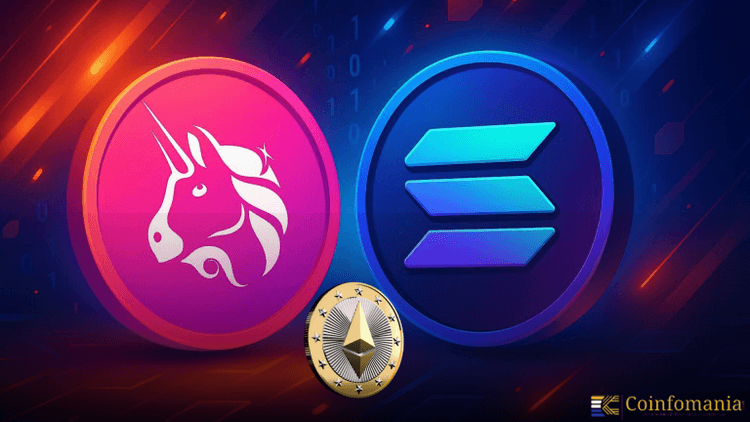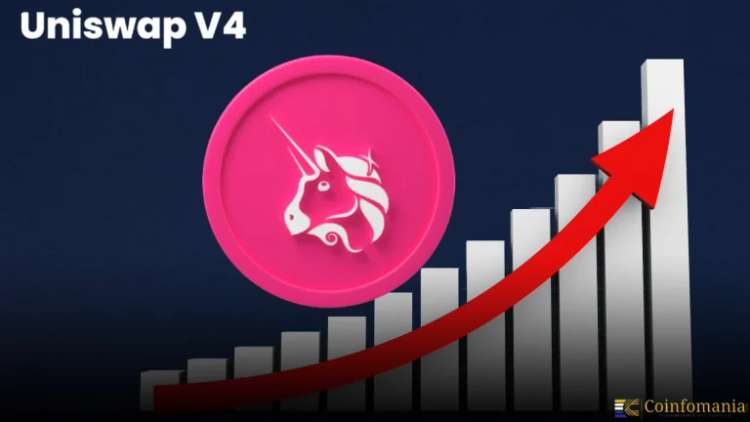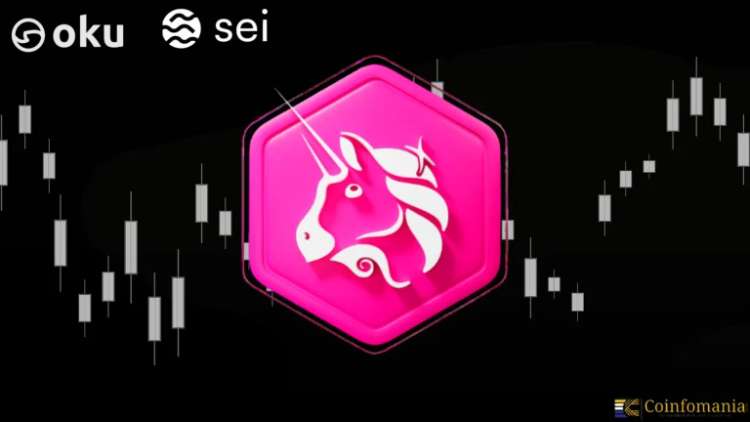UNI
As of December 19, 2025, Uniswap (UNI) is trading at approximately 7.56 USD, reflecting a -3.86% decrease from the previous close.
| Current Price | 24h Price Change | 7-Day Avg Price | Support Level | Next Resistance |
| $7.56 USD | -3.86% | $10.41 USD | $4.66 USD | $18.90 USD |
📈 Technical Analysis Summary
- Price Movement: The -3.86% decrease indicates Bearish pressure; potential uncertainty or profit-taking.
- 7-Day Average Comparison: Trading below the 7-day average ($10.41 USD); weak or consolidating trend; watch for support breakdown.
- Support and Resistance Levels: Price is above support ($4.66 USD); confirms bullish base. Room for growth before hitting resistance ($18.90 USD).
- RSI Analysis: RSI at 57.73 indicates Neutral zone; balanced market.
- MACD Analysis: Negative MACD (-0.11); suggests bearish momentum.
📊 Market Sentiment
| Indicator | Value | Interpretation |
|---|---|---|
| RSI | 57.73% | Neutral; neither overbought nor oversold |
| MACD | -0.11 | Bearish; suggests downward momentum |
| Above 7-Day Avg? | No | Indicates bearish pressure or cooling off |
| Above Support? | Yes | Suggests price stability above support. |
Uniswap Price Prediction Preview
| Forecast Range | Prediction Trend |
|---|---|
| Daily | 📉 Bearish — Caution in the short term due to weakening indicators |
| Weekly | 🔻 Weak — Risk of short-term pullback if support breaks |
| Monthly | ⚠️ Watch volume — Potential trend exhaustion in UNIUSD |
| Yearly | 🧯 Uncertain — Macro factors may limit long-term upside for UNIUSD |
Related News

Uniswap Expands Beyond Ethereum, Adds Solana Token Trading
Uniswap is the world’s largest decentralized exchange. It has officially expanded its trading options to include Solana tokens. This move marks the platform’s first venture outside the Ethereum ecosystem. This signals a new chapter in Uniswap growth. The integration comes after months of speculation about whether Uniswap would ever support a non-EVM (Ethereum Virtual Machine) […]
Shweta Chakrawarty
Author

Uniswap v4 Milestone Signals Growing Strength in DeFi Market
Hanan Zuhry
Author

Uniswap Live on Sei via OkuTrade as DeFi Momentum Grows
Shweta Chakrawarty
Author

Hayden Adams Hails Growth of Decentralized Finance Since 2018 as SEC Pushes for Legal Clarity on Blockchain and On-Chain Software Systems
Deepika Kapparapu
Author

GoPlus SafeToken Locker Introduces Full Support for Uniswap v4 Pools, Offering Improved Gas Efficiency and Flexible Locking Periods
Mikaeel
Author
Uniswap is a decentralized cryptocurrency exchange that runs on the Ethereum blockchain and allows users to conduct a token swap without any third parties involved. Launched in 2018, the DEX has grown to become the largest by trading volume and allows high liquidity with a great range of tokens. Its model is based on an automated market maker (AMM); trades are facilitated without traditional order books thanks to liquidity pools. UNI is Uniswap’s native token that gives holders governance right to vote on protocol upgrades and changes. Now Uniswap, as a DeFi pioneer, takes part in the crypto market's development.
How Does Uniswap Work?
The funds are traded within the liquidity pools themselves — users can supply a pair of tokens, such as ETH and DAI, together, and their tokens become liquidity. These pools are used to execute trades by swapping tokens inside of it, and trades are settled by the constant product formula (x * y = k), which determines the price of them. All of this is done so that this formula will result in the product of the reserves of these items remaining constant, while prices are adjusted dynamically based on supply and demand. The liquidity providers earn a share related to their contribution for a small share of the trading fees, typically 0.3% trading fees per trade. This model does away with the traditional order books, which means there is no time of the day or day of the week in which the trading automation is turned off (Uniswap Docs).
Uniswap and Other Decentralized Exchanges
It is a testament to the growing support for Uniswap in both users and tokens, which have flocked to the DEX with high liquidity and extensive adoption of their tokens. Competitors like SushiSwap, PancakeSwap, and Curve Finance offer unique features. Binance Smart Chain contains PancakeSwap, which gives lower fees and Curve Finance, which deals a lot in stablecoins with low slippages. The multi-token pools can have custom weights provided by the Balancer. With competition, Uniswap has the first-mover advantage, upgrades continue (i.e. concentrated liquidity in V3), and strong community support, it keeps the top spot (DEX Comparison).
Technology Behind Uniswap
Each liquidity pool is made up of a pair contract, which holds reserves of tokens, and both run on Ethereum using smart contracts. The token adheres to the ERC-20 standard, which allows it to be compatible with many tokens. Open-source protocol, licensed with GPL, and through non-upgradeable contracts, the protocol promotes its transparency and security. It uses a constant product formula of type x * y = k, from which prices adapt according to its AMM model. The architecture of Uniswap is compatible with cross-chain functionality on blockchains such as Polygon (Uniswap V2 Overview) and Optimism (Uniswap V2 Overview).
Is Uniswap a Good Investment?
If you invest in UNI, it's similar to exposure to DeFi growth as well as participation in governance. Protocol changes can be voted by UNI holders and help to shape the protocol’s future. Analysts give price predictions ranging from UNI being valued at $40 by 2027 to $100 or more by 2030, pumped up by DeFi’s expansion. However, there are risks such as market volatility, regulatory uncertainties, and competition.
Legal and Regulatory Considerations 2025
As DEX such as Uniswap are evolving, the regulations are evolving in 2025. In the U.S., the question of whether different cryptocurrencies fall into the category of securities (under SEC jurisdiction) or commodities (that of CFTC) is open to debate and has implications for DEX compliance. Decentralized platforms may have a difficult time staying in compliance thanks to their permissionless nature, but the Markets in Crypto-Assets (MiCA) regulation that will serve as the EU’s framework is considerably more tamper-proof.
In the world, there are significant differences when we talk about DEX regulatory approaches, some countries accept them, and some restrict them. In terms of regulatory outlook, users must stay updated on local laws, as regulatory changes can have an effect on the UNI value or Uniswap operations.
How to Buy and Trade on Uniswap
- You will need a compatible wallet like MetaMask or Coinbase Wallet to trade on Uniswap.
- Connect your wallet, go to the Uniswap interface (Uniswap App), choose tokens to swap (e.g. ETH for UNI), and set the slippage tolerance to 0.1% to 1%.
- Check transaction details, including gas fees and confirm in your wallet.
- You should have enough ETH to cover the gas, which is affected by network congestion.
Additional fees are associated with the approval of token on first-time swaps. Always check contract addresses to prevent yourself from scams.
Uniswap Wallets and Security
There are several supported wallets that include MetaMask, Ledger, Trust Wallet and Coinbase Wallet among others. As users control their funds, it is very important for security. Best practices include:
- For large holdings, hardware wallets (Ledger Nano X) can be used.
- Enabling two-factor authentication (2FA) where available.
- Verifying contract addresses before interactions.
- Keeping wallet software updated.
- The complete locking of the seed phrases safely, including avoiding phishing.
- Check transaction history regularly for unauthorized activity (Wallet Guide).
How to Secure Your Uniswap Holdings
Proactively securing UNI and other tokens is required.
- Hardware Wallets stores large amounts offline, such as with Ledger.
- 2FA: Enable two-factor authentication on wallets.
- Confirm contract addresses to prevent malicious interactions with contracts.
- Tolerance: Here you have to set how much slippage to accept to avoid being front run.
- Stay up to date about DeFi scams and security practices through education.
- Private keys and seed phrases must not be shared.
- Approval Revocation: Revoke unnecessary token approvals.
- To minimize risks, monitor transactions and use trusted platforms (Security Tips).
Uniswap Adoption and Use Cases
With millions of users and a monthly trading volume in the billions, Uniswap is one of the cornerstones of DeFi. Its use cases include:
- Token Swapping: Exchanging ERC-20 tokens directly from wallets.
- Pools earn you fees by providing the liquidity they request.
- Meets: DeFi integration, including lending, borrowing, and yield farming.
- Cross-Chain Trading: Operating on Polygon, Optimism, and other blockchains.
- Governance: protocol development will be in the hands of UNI holders.
- This makes the innovation permissionless, so anyone can try to create a token pair.
Future Outlook & Potential of Growth at Uniswap
Looking at Uniswap’s future, the future is quite promising because of:
- Growing DeFi Adoption — The more DeFi is adopted, the more relevant Uniswap becomes.
- Multi-Chain Support: Deployment on a number of blockchains is enabled.
- V3’s feature of the concentrated liquidity and potential V4 breakthroughs improve the efficiency.
- UNI holders govern UNI through adaptive development.
Pros and Cons of Investing in Uniswap
Pros | Cons |
Market leader with high liquidity | High price volatility |
Governance participation via UNI | Regulatory uncertainties |
Growth potential with DeFi | Competition from other exchanges |
Ecosystem utility (fees, staking) | Technical risks (smart contracts) |
Final Thoughts
They are pioneers in decentralized finance by providing a permissionless platform that allows for trading and liquidity provision. Its AMM model has rocked crypto trading for years, and its expansion to multiple blockchains means it now has more reach. UNI, however, provides for investment opportunities, but this comes with the risks, namely, volatility and regulation. At Uniswap’s origin, one can already see the ability of decentralized technologies to change finance. For this reason, Uniswap is among the key players to keep an eye on in the developing crypto scene.
Frequently Asked Questions
What is Uniswap, and what is its operating system?
Uniswap serves as an open exchange platform on Ethereum that facilitates ERC-20 token swaps directly between wallet accounts. The system depends on Automated Market Makers instead of standard order books. Pools of depositing users trade tokens and earn part of the transaction fees from the overall system. Trading data emerges from an algorithm called constant product formula, which sets market value through multiplication (x * y = k).
What is a UNI token used for?
UNI serves as the governing token of Uniswap protocol. UNI owners exercise their governance rights by submitting and voting on plans that control how Uniswap runs, including fee structure choices, technical updates, and investment plans. UNI offers investors a way to support the future expansion of both Uniswap and DeFi platform development. Although UNI produces no automatic earnings, users can earn passive income through governance activities using their tokens.
How do users trade cryptocurrency on the Uniswap platform?
Open the Uniswap App using an Ethereum-enabled wallet like MetaMask to start trading. Choose the tokens for exchange and indicate their number along with the acceptable price fluctuation in the settings panel. You need to approve the trade on this wallet platform after confirming there are enough Ethereum tokens to handle gas expenses. The service works right away because it operates without a central authority being involved.
Is Uniswap safe to use?
People see Uniswap as a trustworthy platform because its programming code is public and regularly checked by auditing teams. While the platform remains secure, overall users face danger from technical issues and manipulation in the trading process. People need to keep their wallets secure plus set trade buffers while checking definite token exchange addresses.
What are Uniswap’s trading fees?
Most Uniswap pools have a 0.3% trading fee applying to all transactions except custom pools, which may have different rates. Liquidity providers get their share of this fee in proportion to their investments in the pool. Users now have multiple fee options for their trading on Uniswap V3 with versions of 0.05%, 0.3%, and 1%. These settings vary based on coin sets and pool types.
Does Uniswap let users earn passive income?
Users can get paid passive income resources by serving as a liquidity provider. Through Uniswap pools users add matching token assets to earn fees when others trade them. Depositing assets with Uniswap holds possible losses when asset market prices shift while being held in the pool. Placing transactions in stablecoin and concentrated liquidity pools of V3 helps lower the risk of permanent loss.
What does focused liquidity mean when using the Uniswap V3 platform?
Under V3 LPs can set specific price ranges they want to support rather than cover the entire price curve on Uniswap. The strategy helps investors use limited capital better while earning more fees, plus enables improved protection against risk events. Users of this method can lose their funds permanently if the market price goes beyond their chosen price range.
Which wallets support Uniswap?
Uniswap works with MetaMask, Coinbase Wallet, Trust Wallet, Ledger, and Trezor Ethereum-compatible wallets. Through these wallets, users keep complete control over their money. People seeking top security should store their valuable UNI holdings and liquidity pool tokens in hardware wallets.
Is Uniswap regulated?
The platform runs as an automatic network protocol with no external authority by 2025. A decentralized exchange encounters more difficulties enforcing rules than a regular exchange. The global rise in regulation could lead Uniswap to change how it operates, especially through KYC/AML requirements and governance token classifications.
Can I trade on Uniswap beyond Ethereum blockchains?
Yes. Uniswap now allows traders to use its platform on various blockchains, including Polygon, Optimism, and Arbitrum. Users gain access to quicker transactions alongside reduced transaction fees by using both secondary blockchain networks and Layer 2 platform. The exchange looks almost identical, while users need to either transfer their assets from Ethereum or access chain-native versions of tokens.